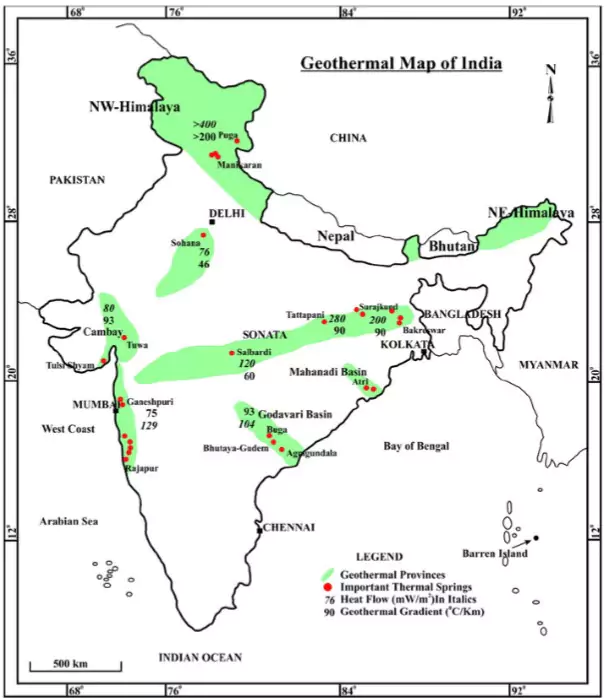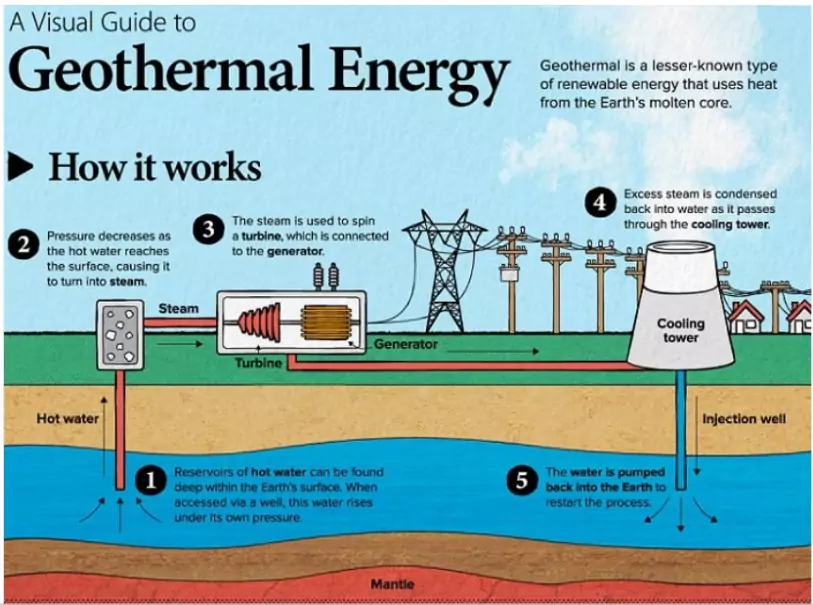Recently, the Ministry of New and Renewable Energy (MNRE) has notified India’s first national geothermal energy policy to unlock untapped geothermal resources.
About India’s First National Geothermal Energy Policy (2025)
- Clean Energy Push: The policy aligns with India’s roadmap to achieve Net Zero emissions by 2070 and aims to diversify renewable energy sources beyond solar and wind.
- Vision & Goals:
- Mainstreaming Renewables: To make geothermal energy a key pillar of India’s renewable mix alongside solar, wind, bioenergy, and hydropower.
 Harnessing Potential: To unlock 10,600 megawatts (MW) potential, contribute to energy security, and provide reliable base-load power.
Harnessing Potential: To unlock 10,600 megawatts (MW) potential, contribute to energy security, and provide reliable base-load power.- Decarbonisation Pathways: To decarbonise buildings, industries, agriculture, and urban spaces through ground source heat pumps (GSHPs) and direct-use applications.
- Institutional Strengthening: To build a robust public–private ecosystem, ensure capacity building, and adopt global best practices.
- Identified Potential:
- Survey and Provinces: Geological Survey of India (GSI) has mapped 381 hot springs and 10 geothermal provinces, including Ladakh, Himachal Pradesh, Gujarat, Chhattisgarh, and the Sone-Narbada-Tapti Lineament Zone basin SONATA Basin.
- High-Enthalpy Potential: Sites such as Puga–Chumathang (Ladakh) are earmarked for electricity generation.
- Medium/Low-Enthalpy Applications: Zones with moderate and low thermal gradients are targeted for direct uses like greenhouse heating, aquaculture, and industrial processes.
- Key Features of the Policy:
- Exploration & Data Repository: Systematic geological, geochemical, and geophysical surveys; creation of a National Geothermal Resource Repository in collaboration with Ministry of Mines, Directorate General of Hydrocarbons (DGH), and CSIR–National Geophysical Research Institute (NGRI).
- Repurposing Abandoned Oil & Gas Wells: Collaboration with Oil and Natural Gas Corporation (ONGC) and petroleum companies to retrofit idle wells for geothermal extraction.
- Ground Source Heat Pumps (GSHPs): Promotion of GSHPs for 24/7 heating and cooling, leveraging shallow ground temperatures (10–25 °C).
- Joint Ventures: Encouragement of partnerships between geothermal developers, oil companies, and mineral firms to pool expertise and capital.
- Fiscal Incentives: Tax holidays, accelerated depreciation, import duty exemptions, concessional land leases, viability gap funding (VGF), and green bonds to de-risk investments.
- Foreign Direct Investment (FDI): Up to 100% FDI allowed in geothermal, with concessional loans and multilateral funding encouraged.
- Project Tenure: Geothermal projects supported for 30 years, with extensions based on resource availability.
- Direct Applications: Policy promotes use in cold storage, horticulture drying, greenhouse heating, aquaculture, and geo-tourism, apart from power production.
- By-products & Minerals: Extraction of valuable minerals like lithium, silica, and boron from geothermal fluids is permitted under the Mines and Minerals (Development and Regulation) Act, 1957.
- Environmental Safeguards: Compliance with Environment Protection Act (1986), Forest Conservation Act (1980), and Wildlife Protection Act (1972) to ensure sustainability.
About Geothermal Energy

- Definition: Geothermal Energy refers to the heat stored beneath the Earth’s crust, generated primarily through radioactive decay and movement of magma.
- This heat can be accessed through hot water reservoirs, natural steam, or hot rock formations.
- Applications: It is used for electricity generation, heating and cooling systems, industrial processes, and water purification.
- Unlike solar and wind energy, which are intermittent, geothermal energy provides continuous, base-load renewable power.
- Technologies Used: The three major technologies used in power plants are:
- Dry Steam Plants: Directly use geothermal steam to turn turbines.
- Flash Steam Plants: Use high-pressure hot water that rapidly vaporises (“flashes”) into steam.
- Binary Cycle Plants: Use moderately hot water (below 200 °C) to heat a secondary fluid with a lower boiling point, which then drives the turbine.
India’s Geothermal Energy Landscape
- Geothermal Atlas (2022): The Geological Survey of India (GSI) published a Geothermal Atlas identifying 381 thermally anomalous areas across the country.
- Estimated Capacity: India possesses an estimated 10,600 megawatts (MW) of geothermal power potential, spread across diverse geological regions including the Himalayas, Gujarat, Maharashtra, SONATA Basin, Godavari Basin, and Northeastern states.
- Major Reservoirs:
- Puga–Chumathang region (Ladakh): High-temperature reservoirs up to 240 °C, suitable for flash or binary power plants.
- India’s first and the world’s highest geothermal energy project is being developed in the Puga Valley of Ladakh. The Oil and Natural Gas Corporation (ONGC) is implementing the project at an altitude of over 14,000 feet.
- Tatapani–Surajkund belt (Chhattisgarh/Jharkhand): Medium enthalpy fields of 110–150 °C.
- Cambay Basin (Gujarat): Medium to high enthalpy, with scope for both power and direct-use applications.
International Precedence of Geothermal Energy
- Global Capacity Benchmark: As of end-2024, the world’s installed geothermal capacity stood at 15.4 gigawatts (GW), led by the United States, Indonesia, and the Philippines.
- Germany’s Energy Transition: Germany is fast-tracking geothermal projects to achieve its 2030 renewable energy targets, treating geothermal as a reliable baseload complement to wind and solar.
- United States & Big Tech: In the United States, Big Tech companies are increasingly exploring low-carbon geothermal electricity to power Artificial Intelligence (AI) data centers, reflecting its role in the future of digital infrastructure.
- The Geysers Complex in California is the world’s largest geothermal field, producing approximately 1,500 MW of power, supplying clean electricity to millions of homes.
- Kenya: The Olkaria Geothermal Complex generates nearly 989 MW, meeting around 40% of Kenya’s electricity demand, making it a leader in Africa’s renewable energy.
- Turkey: With an installed geothermal capacity of 2 gigawatts (GW), Turkey is among the top five producers globally, and also uses geothermal energy extensively for greenhouses and district heating systems.
- Iceland: Nearly 100% of households are heated using geothermal energy. The Reykjanes Power Plant alone generates 130 MW from high-temperature reservoirs.
Strategic and Socio-Economic Significance of Geothermal Energy
- Clean & Reliable Base-Load Power: Provides 24×7 electricity, ensuring grid stability, energy security, and powering critical infrastructure while emitting 99% less CO₂, supporting Net Zero 2070 and Paris Agreement targets.
- Energy Security & Reduced Fossil Dependence: Repurposes abandoned oil and gas wells, lowering reliance on coal and petroleum, cutting import bills, and enhancing strategic autonomy.
- Economic Growth & Rural Development: Enables geo-tourism, industrial heating, greenhouse farming, aquaculture, and cold storage, creating jobs, MSME opportunities, and rural income streams, while supporting remote electrification and balanced regional growth.
- Mineral & Technological Advantage: Hot brines contain lithium, silica, boron, and cesium, supporting EV battery and electronics industries; integrates with AI-driven cooling, green hydrogen production, and carbon capture, promoting next-gen energy innovations.
- Global Competitiveness & Collaboration: Positions India as a renewable energy leader, aligns with geothermal hubs like the USA, Indonesia, and Philippines, strengthens climate diplomacy, and enables technology transfer.
Global Initiatives in Geothermal Energy
- International Renewable Energy Agency (IRENA): Provides capacity building, policy guidance, and technical expertise for countries tapping geothermal.
- World Bank Geothermal Development Program: Offers financing, risk mitigation funds, and feasibility study support for developing nations.
- European Union Green Deal: Supports geothermal expansion with cross-border innovation funds and renewable energy integration projects.
|
Policy and Institutional Framework for Geothermal Energy in India
- National Geothermal Energy Policy (2025): Announced by the Ministry of New and Renewable Energy (MNRE), the policy provides a national framework for exploration, pilot projects, use of abandoned oil wells, private investment incentives, and foreign collaborations.
- Research and Development (R&D): The MNRE Renewable Energy Research and Technology Development Programme funds data collection, resource mapping, feasibility studies, and pilot plants. Collaborations are ongoing with IIT Bombay and the ONGC Energy Centre for advanced drilling and enhanced geothermal systems.
- Institutional Mechanism: In 2024, the MNRE established a National Task Force on Geothermal Energy to prepare a roadmap, create technical standards, and reduce investor risks.
- State-Level Policies:
- Uttarakhand: The Government of Uttarakhand introduced a Geothermal Energy Policy 2025 to encourage applications in heating, cooling, water purification, and electricity generation.
- The policy also provides 50% financial assistance for preparing Detailed Project Reports.
- Gujarat and Ladakh: Identified as priority zones for upcoming demonstration projects, particularly in Cambay Basin and Puga Valley.
Challenges in Harnessing Geothermal Energy in India
- High Capital Costs: Drilling and exploration require significant upfront investment.
- Examples: The Cambay Basin (Gujarat) pilot was stalled due to financial non-viability despite initial interest.
- Exploration Risks: Geological uncertainty makes many wells commercially unviable, resulting in sunk costs.
- Example: Geothermal drilling at Puga, Ladakh in 2023 was halted after unexpectedly high fluid pressures and volumes caused a wellhead blowout, forcing the ONGC contractor to suspend the project.
- Remote Locations: High-potential sites such as Puga in Ladakh face challenges of difficult terrain, altitude, and lack of infrastructure, making power evacuation costly.
- High-potential geothermal sites are largely restricted to tectonic plate boundaries, limiting widespread deployment and making resource accessibility and power evacuation in remote areas a major challenge.
- Regulatory Bottlenecks: Delays in land acquisition, environmental clearances, and inter-agency coordination slow down project approvals.
- Example: The Cambay JV (ONGC–Talboom) project in Gujarat was stalled in 2012 due to delays in statutory approvals and unresolved land-use rights, underscoring regulatory bottlenecks.
- Limited Expertise and R&D: Unlike solar and wind, India has few trained geothermal professionals. Also, annual budget allocations for geothermal under MNRE remain minimal compared to solar/wind R&D (MNRE Reports, 2024).
- Environmental Risks: Risks include land subsidence, contamination of groundwater with geothermal fluids, and seismic concerns if drilling is not scientifically managed.
- Financing Gaps: Not covered under Renewable Energy Certificates (RECs) or mainstream green finance, limiting private appetite (Central Electricity Regulatory Commission (CERC), 2024).
Way Forward
- Dedicated Authority: Establish a National Geothermal Development Board (NGDB) to provide single-window clearances, streamline inter-ministerial coordination, and reduce regulatory delays.
- Financial Incentives: Offer Renewable Energy Certificates (RECs), carbon credits, exploration grants, viability gap funding, and concessional loans to attract private investment and mitigate high upfront risks.
- Capacity Building: Develop geothermal engineering courses at IITs and Green Technology Universities, alongside on-field training with GSI and ONGC, to build a skilled workforce.
- Technology Integration: Invest in Enhanced Geothermal Systems (EGS), binary cycle plants, and hybrid solutions combining geothermal with hydrogen storage or heat networks for industrial and urban applications.
- Global Partnerships: Collaborate with Iceland, Kenya, and Germany for technology transfer, joint research, financing models, and best-practice adoption.
- Community Engagement: Implement benefit-sharing frameworks, local employment schemes, and environmental safeguards to secure social consent and minimize opposition.
Conclusion
India’s Geothermal Energy Policy 2025 is a milestone in diversifying renewables, ensuring clean baseload power while upholding sustainable development, cooperative federalism, and climate justice. It aligns with SDG 7 (Clean Energy) and SDG 13 (Climate Action), echoing Ambedkar’s vision of constitutional morality guiding progress.
![]() 17 Sep 2025
17 Sep 2025

 Harnessing Potential: To unlock 10,600 megawatts (MW) potential, contribute to energy security, and provide reliable base-load power.
Harnessing Potential: To unlock 10,600 megawatts (MW) potential, contribute to energy security, and provide reliable base-load power.
